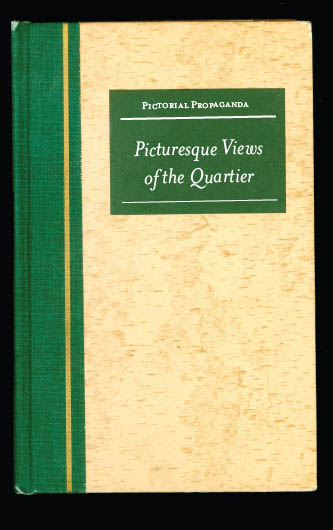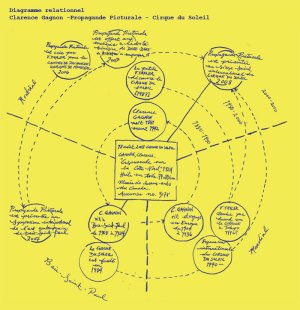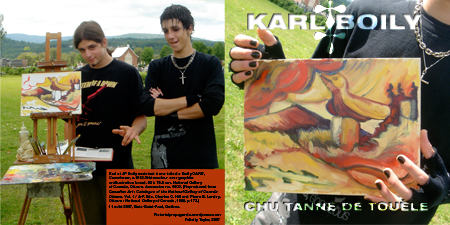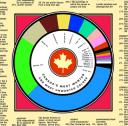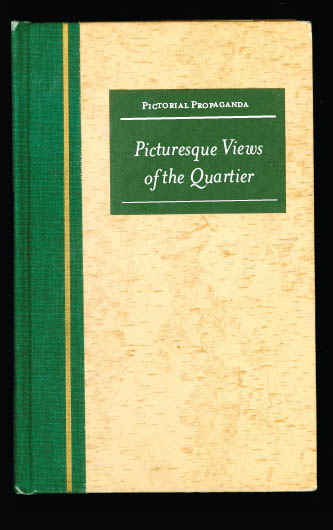Comment rencontrer un vampire : babillard communautaire
Pendant que je peignais au quai, un monsieur m’a approché en demandant « c’est toi la fille avec qui l’on peut négocier ? » Il avait fait le tour du Symposium et par hasard, il était venu à la plage et il m’avait vue de loin sur le quai.
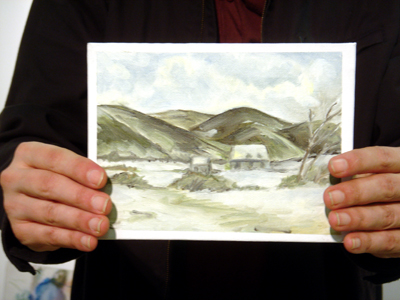
09 July 2006, Atwater Market, Montreal
GAGNON, Clarence. In the Laurentians, Winter, 1910, oil on canvas. 60.0 x 81.3 cm. National Gallery of Canada, Ottawa. Accession no. 357. (Reproduced from Canadian Art : Catalogue of the National Gallery of Canada Ottawa. Vol. 2 / G-K. Ed. Pierre B. Landry. Ottawa : National Gallery of Canada, 1994. p. 15.) Traded for an experience lived in his place.
On a passé un peu de temps ensemble. Il était en vacances avec très peu des possessions personnelles et c’était difficile pour lui de trouver quelque chose à échanger. Je lui ai proposé de prendre quelque temps pour réfléchir et qu’il pouvait me rejoindre à Montréal pour faire le troc. Il m’a répondu qu’après aujourd’hui il n’existe plus. Continue Reading »
Posted in Échanges / Exchanges, Toiles / Paintings | 187 Comments »
Click here for the Perfect-bound paper-back book
And here for the PDF download
This book includes a critical essay on Elizabeth Simcoe by Denis Longchamps, and has been added to the list of required readings for Cynthia Hammond’s, City as Palimpsest graduate seminar at Concordia University.
I wanted to try out print on demand online publishing, as a recent iteration of democratic distribution of information, so here is the result from Lulu.com : a little pocket book that resumes my encounters in the Quarties des Spectacles in 2008. I think it looks pretty nice and the response so far has been positive. As far as the POD experience goes, overall I was pleased with how easy the Lulu interface handled my files, and it was a fairly painless process. Shipping prices to Canada are exaggerated, and although the user forums promise that this will be resolved soon, I wanted to make sure that a download was available as another shipping-free option (although I recommend the paper experience). I kept the costs as low as possible but you can still contact me if you want to make a trade for it.
Description : Elizabeth Posthuma Simcoe (1762-1850) was an early tourist passing though Montréal she traveled with her husband on his way to found the city of Toronto. Felicity Tayler and Denis Longchamps study the relationship between Simcoe’s picturesque watercolours and the present-day touristic development in the heart of downtown Montréal. For more history on the project, search Simcoe or Quartier des Spectacles on the blog.
Posted in Uncategorized | Leave a Comment »
The environment as a processor of information is propaganda. Propaganda ends where dialogue begins.” — Marshall McLuhan, Quentin Fiore. The Medium is the Massage. (Toronto : Bantam Books, 1967), 142
Posted in Bibliographie / Bibliography, Culture, Environnement / Environment |
Posted in Échanges / Exchanges, Culture | 1 Comment »
This week in Sackville I am painting images of the town and of the surrounding countryside that were painted in the late 19th century by the artists John Hammond and Ethel Ogden. Ethel was quite an accomplished and innovative painter for her short life but the only recognition she received in her time was a short mention in the local paper of her china painting.
There is an unconfirmed story of a relationship between the two of them that has surfaced occasionally this week. There is some evidence that Ethel may have been instrumental in bringing Hammond to Sackville in 1893 with the Owens Art Collection. She studied under him in Saint John and then continued as a colleague in Sackville. The extent of the relationship is not clear, but he was her teacher and mentor and they would have gone out together to do plein air landscape painting. Many of their compositions are uncannily similar. Ethel died at a young age of tuberculosis but before this Hammond had married someone else.
Posted in Culture, Nature humaine / Human nature | Leave a Comment »
Opened up a dialogue with Saint John this evening on a community radio program called Serf City at CFMH 107.3 FM (free, public access to the airwaves for anyone who may be interested in being on the air). Thanks to the host Mark Leger and producer Mike Parker for asking me to share the airwaves with them and the community of Saint John.
Posted in Échanges / Exchanges, Culture | Leave a Comment »
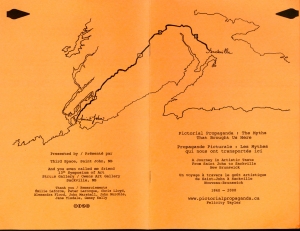
This fall, Pictorial Propaganda will retrace the history of the New Brunswick Museum and the Owens Art Gallery from Saint John to Sackville. As they both can claim to be the “oldest” – the oldest continuing museum in the case of the former, and the oldest university art gallery for the latter, I am interested in these histories and its impact on artists and artistic taste in the region. In Saint John, I will set up a portable easel and reproduce landscape paintings from the New Brunswick Museum’s collection in the recently built tourist attraction of Market Square. In Sackville, I will reproduce landscape paintings from the Owens Art Gallery’s collection in various locations that reflect the daily movements of the town’s inhabitants. This will open a space for dialogue between myself and the local residents, they’ll even have a chance to trade something with me for one of the paintings that result from the performance. It is an opportunity to slow down time, create intimacy with strangers and to subvert the systems of global capitalism that are at work around us.
Third Space / Tiers epace …. Struts Gallery …. Owens Art Gallery
Les mythes qui nous ont transporté ici
Cet automne Propagande Picturale retracera l’histoire du Musée du Nouveau-Brunswick et du Owens Art Gallery de Saint-John à Sackville. Tous les deux s’annonce comme le « plus ancien » – le plus ancien musée toujours actif dans le cas du premier et la plus ancienne galerie d’art universitaire dans le cas du deuxième. Je m’intéresse à ces histoires et leur impact sur les artistes et le goût artistique de la région. À Saint-John, je m’installerai avec mon chevalet portable afin de reproduire des paysages de la collection du Musée du Nouveau Brunswick dans le « Market Square, » récemment aménagé pour les
touristes. À Sackville, je reproduirai des paysages de la collection du Owens Art Gallery dans plusieurs lieux représentant l’itinéraire des résidants de la ville. Cela me permettra d’entreprendre un dialogue avec les résidents, qui auront également la chance d’échanger quelque chose contre une de les peintures résultant de la performance. C’est l’opportunité de ralentir le temps, de crée une intimité avec les inconnus et de subvertir les forces économiques de la mondialisation autour de nous.
Posted in Culture, Paysage / Landscape | Leave a Comment »
The idea of merging culture with the economy isn’t new, but the recent discourse surrounding it is… Increase innovation and creativity, the argument goes and the profits will follow… Culture, as collapsed into the creative industries means ‘not the traditional fine arts, nor the modernist cultural industries like cinema and radio, but instead the newly minted and digitized professions that shape the lightweight, complex, ephemeral, ever-changing aesthetic experiences of the hyper-mediated city.’ Nevertheless, the traditional arts continue to play a significant role, for along with the vast flows of immaterial goods – software, IP, experience, entertainment – come the material façades.” — Kirsty Robertson, “Crude Culture” Fuse Magazine, (31.2): 2008, 14. Quoting Brian Holmes. “One World One Dream” Continental Drift : The Other Side of Neoliberal Globalization. Accessed 19 August 2008. http://brianholmes.wordpress.com/2008/01/08/one-world-one-dream/
Posted in Économie / Economy, Bibliographie / Bibliography, Culture |
Felicity Tayler, artiste en arts visuels, utilise l’archétype du tableau de paysage pour créer des liens avec autrui. Elle s’intéresse également aux icônes nationales ainsi qu’aux systèmes économiques et de valeurs. Par ce fait, elle voit cette opportunité comme une redistribution des richesses au sein du milieu culturel contemporain…
Felicity Tayler is a conceptual artist who uses the archetype of western landscape painting as a premise to create relationships. She is also interested in national icons, economics and value systems, and as such she welcomes this opportunity to redistribute wealth within the contemporary cultural milieu…. Continue Reading »
Posted in Échanges / Exchanges, Économie / Economy, Culture | Leave a Comment »
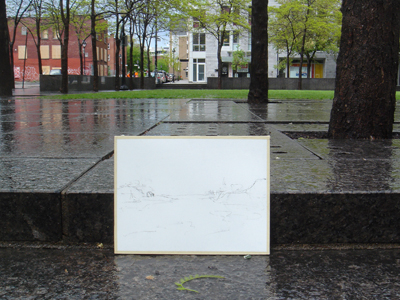
23 mai 2008, Espace Mobile, Vox, Montréal
Elizabeth SIMCOE, “St Helene – Montreal” Cahiers d’esquisse de Elizabeth Simcoe, 1792-1796. Panorama 58-59. Bibliothèque David M Stewart. Fonds Simcoe.
It rained. I was outside for 20 minutes in the Place de la Paix before it poured rain and I had to run inside.
The square is an interesting place. It seems to be so empty. Constructed like modernist sculpture with space in the middle but nothing to encourage people to fill it. Despite this, it is a space that has a great deal of movement and variety. Everything from skater kids using the curb for tricks, or students from the nearby university residence playing soccer in the middle, to the street-involved population stopping for a rest or to congregate and pass some time.
In the brief time I was there I met a woman who I see coming in and out of the peep shows down the block. She has some prison tattoos. She spoke so softly, but wanted me to know that she thought the pink painting of the mountain view was “really pretty.” It began to rain and she disappeared before I could offer it to her.
I also watched from afar as one of the women I met the first day out was “courted” by a man in a car. In the end she didn’t go with him. But later I think she was accosted by another man on the block, he had ripped open the front of her dress in front of everyone and she was really angry. When I first met her, she told me that she paints to express her emotions to the universe.
Posted in Culture, Nature humaine / Human nature, Toiles / Paintings | Leave a Comment »
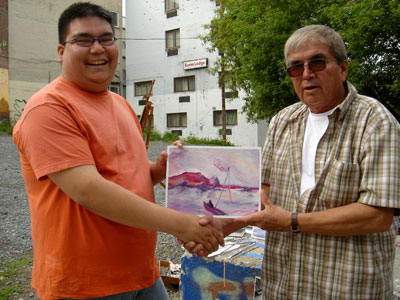
05 mai 2008, Espace mobile, Vox, Montréal
Elizabeth SIMCOE, View of Montreal. ca. 1792. Watercolour. Archives of Ontario, Simcoe Family Fonds, F47. Reference code F47-11-1-0-58. (http://www.archives.gov.on.ca Accessed 10 May 2008 ) Given for stories and time and the chance to hear Montagnais spoken for the first time in my life.
À l’instant même où je m’installais dans l’espace, un homme se reposait sur un des blocs de béton. Il est resté avec moi durant toute la durée de la performance. Quelques passants ont cru que je peignais son portrait. Ce monsieur était accompagné de son fils. Après une demi-heure à partager l’espace, nous avons commencé à dialoguer. J’ai leur demandé s’ils aimaient la peinture paysagiste. Le monsieur a répondu “Je suis un paysage.” Quand j’ai demandé de clarifier sa déclaration, il a ajouté “Je suis toujours dans la nature.” Il avait un bon sens de l’humour. Lorsqu’il parlait, il passsait parfois du français à un langage que je ne connaissais pas. L’homme m’a dit que c’était du Montagnais, sa langue d’origine. J’ai lui dit que c’était la première fois dans ma vie que j’entendais le Montagnais. Son fils m’a dessiné une carte m’indiquant l’emplacement d’une murale, un portrait d’un Chef Montagnais. Cette œuvre se trouve sur la rue St-Hubert.
Ils sont tous les deux de la réserve Uashat mak Mani-Utenam, près de Sept-Îles. J’ai demandé si c’était loin de Montréal. Il a répondu quelques heures par auto… et cinq jours par canoë! Nous avons tous rient et l’homme m’a raconté que jadis ses parents faisaient le voyage en canoë de Sept-Îsles à Sainte-Anne-de-Bellevue dans les années 1950… Continue Reading »
Posted in Échanges / Exchanges, Économie / Economy, Culture | 2 Comments »
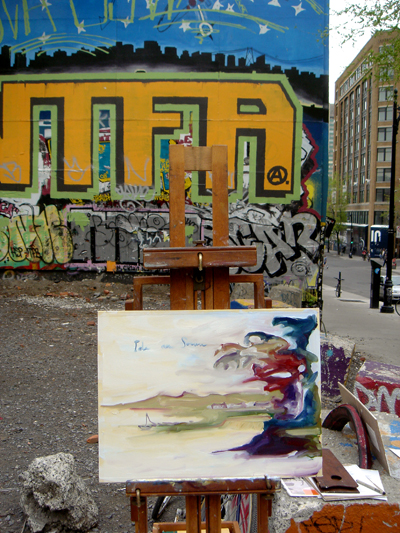
16 mai 2008, Espace mobile, Vox, Montréal
Elizabeth SIMCOE, Isle au Soeurs, July 31. ca. 1796. Watercolour. Archives of Ontario, Reference code F 47-11-1-0-262. (http://www.archives.gov.on.ca Accessed 02 May 2008 )
I’m facing the Living Monument Project. A mural pained by a coalition of sex workers and allies. It was created in 2003 in honour of the 60+ in Vancouver who were murdered or no longer to be found. A lot of people from the Native Friendship Centre (on the corner of Ontario and St-Laurent) also took part, as many of the women who were murdered were aboriginal. Since then it has been mostly covered over with graffitti but you can still see the original skyline peeking out over the top… Continue Reading »
Posted in Économie / Economy, Culture, Toiles / Paintings | Leave a Comment »

13 mai 2008, Espace mobile, Vox, Montréal
Elizabeth SIMCOE, View near Montreal. ca. 1792. Watercolour. Archives of Ontario, Simcoe Family Fonds, F47. Reference code F47-11-1-0-60. (http://www.archives.gov.on.ca Accessed 10 May 2008 ) Traded for a critical analysis.
Denis Longchamps is doing his PhD in Art History on the sketchbook imagery of Elizabeth Simcoe (1762-1850). He is arguing that the sketches she made all along her journey through Upper and Lower Canada in the 18th century were done in order to further the colonialist project of her husband, Lieutenant Governor John Simcoe. Denis’ research has been an integral part of the development of this phase of Pictorial Propaganda in the Quartier des spectacles. My research has been based on his astonishing indexing of all of her sketches among disparate collections on Canada and Europe, as well as his scholarly view of her work as colonialist propaganda.
Denis has offered to make a critical analysis of Pictorial Propaganda (as it reproduces the original watercolours of Elizabeth Simcoe) within the context of his own PhD research.
Posted in Échanges / Exchanges, Bibliographie / Bibliography, Culture, Nature humaine / Human nature, Paysage / Landscape | 2 Comments »
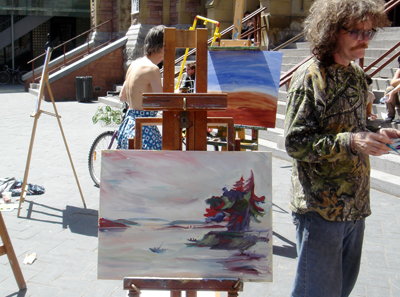
13 mai 2008, Espace mobile, Vox, Montréal
Elizabeth SIMCOE, View near Montreal. ca. 1792. Watercolour. Archives of Ontario, Simcoe Family Fonds, F47. Reference code F47-11-1-0-60. (http://www.archives.gov.on.ca Accessed 10 May 2008 )
Aujourd’hui, nous nous sommes installés dans l’espace public récemment réamennagé situé devant l’église Saint James United. Quelques membres du Centre de jour St-James* m’ont accompagnée pour peindre en plein air. Un gros merci à Anne-Marie, Bernard, Daguy, Daniel, Christine, Jacques, et Zurich (notre Groupe des Sept) qui ont passé une belle après-midi avec moi en partagent leur créativité.
Cette expérience était moins importante pour mes propres rencontres avec le public, il s’agissait plutôt d’une opportunité de mettre en valeur les activités culturelles de la communauté de Saint James United qu’elle ne rend pas toujours visible… Continue Reading »
Posted in Échanges / Exchanges, Nature humaine / Human nature, Toiles / Paintings | Leave a Comment »
Ce lieu-là surpasse encore tous les autres en beauté : car les isles qui se rencontrent dans l’emboucheure de ces deux fleuves (le St-Laurent et la Rivière des Prairie), sont autant de grandes et de belles prairies, les unes en long, les autres en rond, ou autant de jardins faits à plaisir, tant pour les fruits qui s’y rencontrent, que pour la forme et l’artifice dont la nature les a préparées, avec tous les agremens que les Peintres peuvent representer dans leur païsage.” — Jérôme Lalement, Relations des Jésuites, 3, année 1663, p 28 cité dans Jean-Claude Marsan, Montréal en évolution, (Montréal : Éditions Fides, 1974), 31
…par conséquent ce fera un jour un pays tres-propre pour eitre la situation d’une grande et grosse ville. Jérôme Lalement, Relations des Jésuites, 3, année 1663, in The Jesuit relations and allied documents travels and explorations of the Jesuit missionaries in New France, 1610-1791 : the original French, Latin, and Italian texts, with English translations and notes, vol 48, p 168 (Early Canadiana Online)
Posted in Beauté / Beauty, Bibliographie / Bibliography, Paysage / Landscape |
Art production and acts of generosity are fundamentally generative, but nonlinear, expenditures of time and resources. In this way they contradict the accepted functions of production and utility that are associated with meeting societies basic needs, or the process of its expansion. Each could therefore be seen as potential processes of liberation from the inevitable progress of production…Arguably, it is around this kind of expenditure or value system that culture is defined, arising out of the surplus or excess generated by a society. — Kate Fowle and Lars Bang Larsen “Lunch Hour : Art Community, Administrated Space, and Unproductive Activity” in What We Want is Free : Generosity and Exchange in Recent Art. Ed. Ted Purves (Albany, NY : State University of New York Press, 2005), 17
Posted in Économie / Economy, Bibliographie / Bibliography, Culture |

I made a visit to Stella today to pick up some copies of their excellent bilingual independent magazine ConStellation. I had a warm welcome, and as usual enjoyed reading their literature. The magazine is full of strong writing, insights and multifaceted nuances, with a very professional presentation. It generally makes me think about what it means to be human and working – and the commitment it takes to publish your own voice. Continue Reading »
Posted in Échanges / Exchanges, Économie / Economy, Culture |
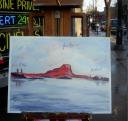
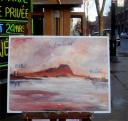
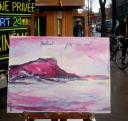
05 avril 2008, Espace mobile, Vox, Montréal
Elizabeth SIMCOE, Montreal from the west. June 30, 1796. Watercolour on wove paper. Library and Archives Canada, Accession no. 1938-223-11. (http://www.collectionscanada.gc.ca Accessed 29 March 2008 ) – image 1 and 2
Elizabeth SIMCOE, Montreal from the west. June 30, 1796. Watercolour. Archives of Ontario, Reference code F 47-11-1-0-265. (http://www.archives.gov.on.ca Accessed 29 March 2008 ) – image 3
Lorsque je prenais ces photos sur le boul. St-Laurent, j’ai rencontré Yvon. Il m’a informée que la Ville à l’intention de démolir tous les édifices de l’autre côté de la rue. Selon lui, c’est un ménage du quartier nécessaire. À cela, Je lui ai demandé s’il souhaitait même la disparition du Montreal Pool Room. Il m’a répondu qu’on peut y manger de très bons hot dogs. Ensuite, il m’a raconté comment il s’est installé dans le coin, il y a de cela plusieurs années. Il m’a avoué qu’à 12 ou 14 ans, il s’est associé à une gang de rue. En y repensant, il a trouvé cette vie malheureuse. Tous les membres de son ancienne gang a déménagé dans le coin de Beaubien et il est le seul à avoir resté dans le quartier.
Posted in Échanges / Exchanges, Toiles / Paintings | 1 Comment »
Under capitalism, all is spectacle. Branding is the antithesis of neighbourhood. How can the symbolic language inherent to branding adjust to a process that includes the local community: the residents who study and work in a neighbourhood, plus the daily flux of permanent and temporary occupants.” — dAb Collective, “Urbanism versus Branding for Montréal’s Quartier des spectacles” Fuse Magazine 29, no 3 (2006), 24.
Posted in Économie / Economy, Bibliographie / Bibliography, Culture |
Le Quartier des spectacles est une des composantes de la nouvelle image de marque de Montréal axée sur la culture et la mise en valeur de son activité créatrice. Il s’agit de la plus récente phase de son développement économique. Je m’intéresse en particulier à l’opinion des gens concernant l’impact socioéconomique et environnemental de ces changements.
The Quartier des spectacles is part of Montréal’s re-branding through culture as a “creative city.” This is the most recent of many phases of economic development in the city’s history. I am interested in public opinion on the impact (socioeconomic and environmental) of these changes.
Posted in Économie / Economy, Culture, Environnement / Environment, Nature humaine / Human nature, Toiles / Paintings | Leave a Comment »
Why did discussions around landscape in Canada before the 1960s tend to champion national difference and distinctiveness, often under the banner of exceptionalism, while more recent debates have focused on issues of colonial power and dispossession, transnational crossovers, and regional idiosyncrasy? What relevance do traditional landscape tropes have in a world of vastly altered political, technological, demographic, and environmental circumstances? And if traditional tropes continue to persist, what does it say about the relationship between contemporary realities and the the authority, power, and influence of conventional understandings of nationhood?” — Beyond Wilderness : The Group of Seven, Canadian Identity, and Contemporary Art. John O’Brian and Peter White Eds. (Montreal : McGill-Queens University Press, 2007), 6.
Posted in Bibliographie / Bibliography, Culture, Environnement / Environment, Nature humaine / Human nature, Paysage / Landscape |

Non sans humeur, en toute modestie, la Montréalaise a voulu tester notre soif pour la possession, jouant sur les apparences, se payant même la tête de l’histoire officielle. Sur son chevalet, devant ce paysage de Charlevoix peint et repeint depuis deux siècles, Tayler reproduit des tableaux tirés d’une encyclopédie canadienne de Musée des beaux-arts du Canada, abandonnée à la lettre K. Les gens aiment ses toiles? Tayler les donne, non pas en échange d’argent, mais contre un objet ou une histoire personnelle.” — Jérôme Delgado. “L’art pour l’art : Le Symposium de Baie-Saint-Paul fête ses 25 ans” Le Devoir. 1er et 2 septembre, (2007), E5.
Samedi le 29, et le dimanche 30 septembre, je serai à Dare-Dare dans le cadre de l’évènement Peinture fraîche / Fresh Paint. Venez me rencontrer ou me faire du troc!
Saturday the 29th and Sunday the 30th of September, I will be at Dare-Dare as part of the event Peinture fraîche / Fresh Paint. Come to see me or to make a trade!
Posted in Échanges / Exchanges, Bibliographie / Bibliography, Toiles / Paintings |
Si on choisit d’échanger des biens matériels, objets ou services, plûtot que des valeurs mésurées monétairement, c’est bien que l’on compte sur les objets pour subvertir ou contourner une économie officielle et les normes du marché. Posons-nous la question de ce que l’on attend des objets, de ce qu’on leur attribu comme pouvoir, de ce qu’on y investit comme croyance. L’objet libéré de sa valeur d’échange, purifié de tout contact avec l’argent, va-t-il révéler sa vraie valeur, valeur d’usage, valeur sentimentale, subjective, valeur sacré, valeur vécu?… L’intérêt de la pratique du troc est de nous confronter directement aux objets, donc en fait à la différence entre les espoires que l’on y investis et leur efficacité réelle.” — Jean-Ernest Joos. “L’objet : entre l’humain et l’inhumain” Esse arts + opinions 49 (2003), 38.
Posted in Échanges / Exchanges, Économie / Economy, Bibliographie / Bibliography |
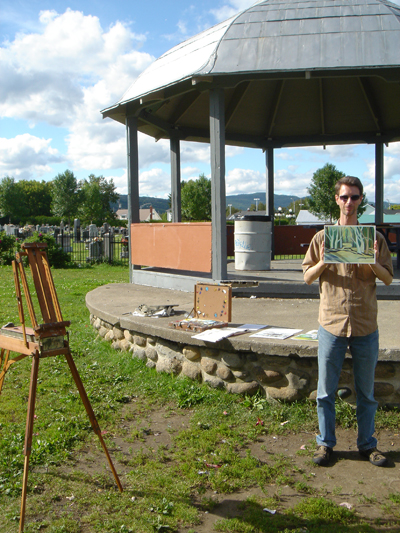
09 août 2007, Pergola,
25e Symposium international d’art contemporain de Baie-Saint-Paul
COSGROVE, Stanley. Landscape, 1948. Oil on paper, mounted on masonite. 66.2 x 102.3 cm. National Gallery of Canada, Ottawa. Accession no. 4983. (Reproduced from Canadian Art : Catalogue of the National Gallery of Canada Ottawa. Vol. 1 / A-F. Eds. Charles C. Hill and Pierre B. Landry. Ottawa : National Gallery of Canada, 1988. p 213.) Traded for two conceptual business cards and a descriptive text.
Je suis très content que tu aies accepté ma proposition de troc pour ta
peinture. Voici donc pour ton blog la description des deux cartes que je t’ai proposées.
La première carte se lit : ” Clara Freeman / Effeuilleuse “, et elle a été conçue à la fin des années 80, alors que je travaillais en ” effeuillant ” le dictionnaire Robert pour réaliser des exercices de poésie conceptuelle; il s’agissait du pseudonyme que j’utilisais parfois pour des actions que je faisais lorsque je travaillais à la revue Inter. (En fait, je n’ai jamais utilisé cette carte, qui est donc demeuré un pur souvenir personnel.)
La deuxième carte, ” prière d’égarer “, est conçue comme un objet paradoxal et un accessoire d’intervention, qu’il m’arrive parfois de laisser dans différents lieux publics : il s’agit, pour quiconque la trouve, de la perdre à nouveau en l’égarant.” — Patrice Loubier
Posted in Échanges / Exchanges | Leave a Comment »
Le chasseur d’ours
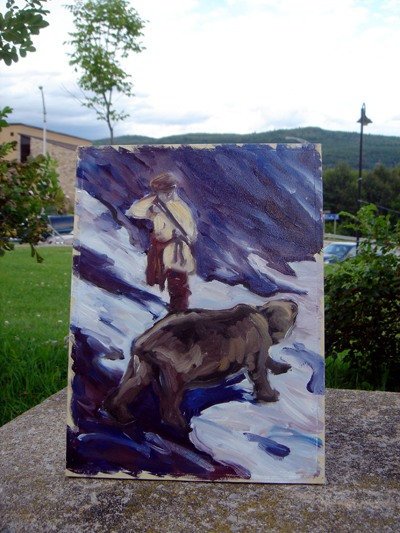
17 août 2007, L’Église
25e Symposium international d’art contemporain de Baie-Saint-Paul
HEMING, Arthur. The Bear Hunter, 1910. Monochrome oil on canvas. 42.6 x 30.9 cm (image); 49.8 x 36.2 cm (canvas). National Gallery of Canada, Ottawa. Accession no. 218. (Reproduced from Canadian Art : Catalogue of the National Gallery of Canada Ottawa. Vol. 2 / G-K. Ed. Pierre B. Landry. Ottawa : National Gallery of Canada, 1994. p. 116.)
Cette toile fut inspirée par un couple de Les Éboulements qui ont une grande ouverture d’esprit, à tel point qu’ils accueillent des gens défavorisés chez eux pour leur faire vivre une expérience dans la nature. Pendant leur séjour, le monsieur accompagne ces gens en randonnée. Il est également un chasseur d’ours. Bien que cette toile n’est pas strictement un paysage, il témoigne d’une image, celle de l’homme dans la nature, identité que nous avons en tant que peuple descendant des coureurs de bois, des chasseurs et des pionniers qui ont exploré ce pays sauvage. Continue Reading »
Posted in Échanges / Exchanges, Environnement / Environment, Nature humaine / Human nature, Toiles / Paintings | 1 Comment »
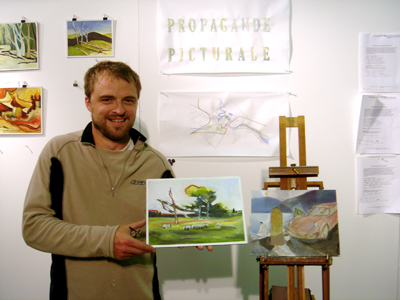
June 18 2007, Marché Atwater / Atwater Market, Montréal
BRYMNER, William. Early Moonrise in September, 1899. Oil on canvas. 74.2 x 102.1 cm. National Gallery of Canada, Ottawa. Accession no. 42. (Reproduced from Canadian Art : Catalogue of the National Gallery of Canada Ottawa. Vol. 1 / A-F. Eds. Charles C. Hill and Pierre B. Landry. Ottawa : National Gallery of Canada, 1988. p. 149) Traded for a painting by Jimmy PERRON. Pêche sur le Porsche, 2007.
La semaine dernière, j’ai fait la connaissance de Jimmy Perron, un artiste de Baie-Saint-Paul, représenté par plusieurs galeries commerciales québécoises. Nous avons eu une petite discussion concernant les différents milieux de l’art. Il m’a expliqué son désir de faire partie du Symposium. Continue Reading »
Posted in Échanges / Exchanges, Économie / Economy, Toiles / Paintings | 1 Comment »
But this is not why she bought the pictures, way back then. She bought them because she wanted them. She wanted something that was in them, although she could not have said at the time what it was. It was not peace : she does not find them peaceful in the least. Looking at them fills her with a wordless unease. Despite the fact that there are no people in them or even animals, it’s as if there is something, or someone, looking back out.” – Margaret Atwood, “Death by Landscape” in Wilderness Tips (Toronto : Emblem Editions, 1999), 92.
A significant difficulty of this project is the vulnerable position I put myself into. This vulnerability is voluntary and part of the boundaries of what I would like to test. How do others choose to treat me when I put myself at their disposition? Where are the limits of respect in our engagement? Will others abuse or take advantage of me?
Posted in Échanges / Exchanges, Bibliographie / Bibliography, Nature humaine / Human nature | 2 Comments »
Karl et J.-P. Boily, deux ados de Baie-Saint-Paul m’ont regardé faire une toile d’Emily Car. Lorsqu’ils m’ont vu assembler mon chevalet devant la pergola (un lieu de rencontre pour les jeunes de la ville), ils ont crié « chu tanné dé touèle » ce qui est tout à fait compréhensible vu qu’ils sont entourés de galeries remplies de jolies toiles à vendre aux touristes. Malgré leur mécontentement, au début de mon installation, ils sont finalement venu me voir et nous avons passé une heure à discuter de l’histoire d’Emily Carr et de leurs préférences musicales (c’était intéressant de voir que leurs choix musicaux étaient très proches des miens à leur âge).
Ils ont une gig au Balcon Vert le 18 août à 21h (c’est gratuit). Leurs inspirations musicales sont Silver Chair et Nirvana. J’ai leur fait une couverture d’album…
11 août 2007, Pergola,
25e Symposium international d’art contemporain de Baie-Saint-Paul
Emily CARR, Cumshewa, c.1912. Watercolour over graphite on illustration board. 52 x 75.5 cm. National Gallery of Canada, Ottawa. Accession no. 6103. (Reproduced from Canadian Art : Catalogue of the National Gallery of Canada Ottawa. Vol. 1 / A-F. Eds. Charles C. Hill and Pierre B. Landry. Ottawa : National Gallery of Canada, 1988. p 173.)
Et voici Karl et Boily en spectacle.
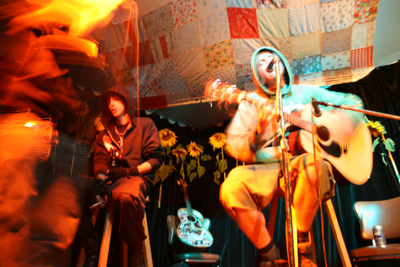
Image de le spectacle au Balcon Vert (Photo pris par Simon Bilodeau).
Je leur ai apporté à chacun une copie de la couverture de l’album avec un CD vierge, pour les encourager à enregistrer leur musique. Je les ai présentés avant qu’ils jouent leur « set ». Ils étaient très nerveux, mais très touchés aussi de recevoir ce souvenir de notre après-midi ensemble, en disant avec politesse qu’ils ne s’attendaient pas à ça.
Posted in Échanges / Exchanges, Culture, Toiles / Paintings | 1 Comment »
Paysage
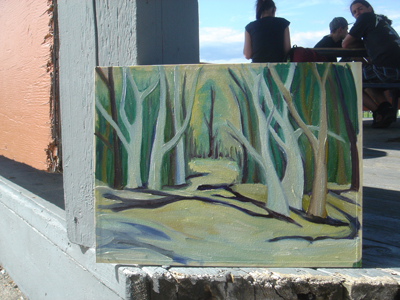
09 août 2007, Pergola
25e Symposium international d’art contemporain de Baie-Saint-Paul
COSGROVE, Stanley. Landscape, 1948. Oil on paper, mounted on masonite. 66.2 x 102.3 cm. National Gallery of Canada, Ottawa. Accession no. 4983. (Reproduced from Canadian Art : Catalogue of the National Gallery of Canada Ottawa. Vol. 1 / A-F. Eds. Charles C. Hill and Pierre B. Landry. Ottawa : National Gallery of Canada, 1988. p 213.)
Un monsieur qui prenait part à un tour à vélo à Charlevoix s’est arrêté pour me parler pendant que j’étais en plein air. Il n’avait pas fait le tour du Symposium, alors j’ai commencé en lui expliquant mon projet. À un certain moment, il m’a interrompue en disant « Est-ce que je t’ai rencontré à Montréal ? » Apparemment, il avait participé au projet au marché Atwater! Il est allé visiter le Symposium à l’intérieur de l’aréna et en revenant il m’a dit avec surprise « J’ai vu ton CV à l’intérieur, tu es une vraie artiste ! » Comme si je ne l’étais pas lorsque j’étais au marché Atwater à Montréal, dans un contexte autre que celui du Symposium.
Posted in Échanges / Exchanges, Toiles / Paintings |
Canada’s Most Wanted and Most Unwanted Colours
Les couleurs les plus et les moins désirées par les Canadiens
Anthony Kiendl, Bruce Grenville. Komar & Melamid: Canada’s Most Wanted and Most Unwanted (Regina : Dunlop Art Gallery, 1999), 8
Posted in Bibliographie / Bibliography, Culture, Nature humaine / Human nature |
L’histoire des paysages en Occident illustre bien la dynamique opérant entre lieux et non-lieux. Cette histoire pourrait en effet être abordée comme une conquête sensible des non-lieux, conquête d’espaces réputés « affreux » ou inhabitables, qui seront progressivement approivisés, investis de valorisations culturelles, transformés en lieux et en paysages. L’art a joué et joue toujours un rôle important dans ce processus… Qu’en est-il aujourd’hui de ces étendues urbanisées, de ce monde qui apparaît de plus en plus limité à mesure que s’accélère le quadrillage extensif opéré par la technique et les réseaux de communication? La paysagéité constitu-t-elle toujours un véhicule conceptuel pertinent pour appréhender et valoriser cette nouvelle condition territoriale?” — Luc Lévesque, “Entre lieux et non-lieux : Vers une approche interstitielle du paysage” in Lieux et non-lieux de l’art actuelle = Places and non-places of contemporary art (Montreal : Les éditions Esse, 2005), 38.
Posted in Bibliographie / Bibliography, Culture, Paysage / Landscape |
…il est important de réconsidérer la place des oeuvres dans le système global de l’économie, symbolique ou matérielle, qui régit la société contemporaine : pour nous, au-delà de son charactère marchand ou de sa valeur sémantique, l’oeuvre d’art représent un interstice social. Ce terme d’interstice fut utilisé par Karl Marx pour qualifier des communautés d’échanges échappant au cadre de l’économie capitaliste, car soustraites à la loi du profit : troc, ventes à perte, production autarciques, etc. L’interstice est un espace de relations humaines qui, tour en s’insérent plus ou moins harmonieusement et ouvertement dans le système global, suggère d’autres possibilités d’échanges que celles qui sont en vigeur dans ce système.” — Nicolas Bourriaud, Esthétique relationnelle, (Dijon : Les Presses du réel, 2001), 16.
Posted in Économie / Economy, Bibliographie / Bibliography, Nature humaine / Human nature |
The Western idea of the autonomous ‘figure in the landscape’ is no longer accepted in critical discourse, yet it remains a pervasive myth in general culture, one that answers to a deeply felt desire for trancendance.” — Petra Halkes, Aspiring to the Landscape : On painting and the Subject of Nature (Toronto : University of Toronto Press, 2006), 145.
Posted in Bibliographie / Bibliography, Nature humaine / Human nature, Paysage / Landscape |
Is “public” a qualifying description of place, ownership or access? Is it a subject, or a characteristic of the particular audience? Does it explain the intentions of the artist or the interests of the audience? The inclusion of the public connects theories of art to the broader population: what exists in the space between the words public and art is an unknown relationship between artist and audience, a relationship that may itself become the artwork.” — Suzanne Lacy, Mapping the Terrain : New Genre Public Art (Seattle : Bay Press, 1995), 20.
Posted in Échanges / Exchanges, Bibliographie / Bibliography, Culture |
The artist with his easel set up in the countryside, painting the scene before his eys, is one of our stock cultural stereotypes. Most people would be surprised to learn how recently this conception has developed – the major movement to outdoor painting having come only with the impressionists at the end of the nineteenth century. Behind this stereotype of the painter sitting behind his or her easel en plein air is a more general assumption that the artists’ role is to respond in some direct visual manner to the perceived external environment… By contrast the idea of a visual artist rejecting the percieved external world as the basis for his art… using his or her own body as the art piece… is still resisted by many people who feel otherwise feel attracted to a world in which art plays an important role.” — Terrence Heath, “A Sense of Place,” in Visions : Contemporary Art in Canada. (Toronto : Douglas & McIntyre, 1983), 45.
Posted in Bibliographie / Bibliography, Paysage / Landscape |
What might appear as contradictory, that is, the fact that economic globalization seems to be accompanied by an increase of cultural divisions, is only so on the surface. It is a fact that, in a world where exchanges of goods and ideas are more and more frequent on an international level, people are increasingly aware of the unique characteristics of their own local cultures. Similarly, and it is particularly obvious in the European Union, the disappearance of the old national borders when it comes to goods and persons, has made the artificiality of these borders very clear: the creation of national identities — a recent phenomenon after all — and the political desire to brand and localize them within artificial boundaries has far too often very little to do with any sense of local belonging. It is not possible to differentiate clearly the elements of local cultures from those of national cultures: if the local culture is made up, for instance, of elements like the language we use with family and close friends, as well as the type of food or clothing one is used to wearing, the national culture is made up, for example, of historical events and stories often associated to the ‘nation-building’ movements of the past.” — Frank Vigneron, “On the occasion of the 10th anniversary of the handover …” Asia Art Archive News Letter 7 June (2007). (Accessed June 20th 2007)
Posted in Économie / Economy, Bibliographie / Bibliography, Culture, Nature humaine / Human nature |
Economic laws appear “to be like natural laws, that they are not made by man to regulate free acts of exchange but are functions of the productive conditions of society as a whole where all activities are leveled down to the human body’s metabolism with nature and where no exchange exists but only consumption” — Hannah Arendt, The Human Condition. (Chicago : University of Chicago Press, 1958), 209 quoted in Kieran Bonner, ” Understanding Placemaking : Economics, Politics and Everyday Life in the Culture of Cities,” Canadian Journal of Urban Research 11, no 1 (2002), 2.
Posted in Économie / Economy, Bibliographie / Bibliography, Nature humaine / Human nature |
The topographical views of military officers were in fact simply one manifestation of the romantic inclination of English gentlemen of the later eighteenth century to delight in the splendours of natural scenery or anything they found in their travels that was charmingly primitive, rough, quaint, or exotic — in a word picturesque. — Dennis Reid. A Concise History of Canadian Painting. 2nd ed. (Toronto : Oxford University Press, 1988), 19.
Posted in Bibliographie / Bibliography, Nature humaine / Human nature, Paysage / Landscape |
A vrai dire la beauté des paysages de Charlevoix n’est perçu que par les premiers visiteurs anglophones vers le milieu du XIXe siècle… Quand, à partir de 1844, un service de vapeurs permet d’amener tous les jeudis les voyageurs de la ville de Québec… Charlevoix change de vocation. Le comté devient un haut lieu touristique, au climat salubre, où l’on peut prendre des bains de mer … «Peu d’endroits au Canada soutiennent la comparaison pour la beauté du paysage», proclament les guides touristiques… La beauté du compté du Charlevoix était donc née, fille improbable du choléra de 1832 et de l’industrie touristique naissante!” — François-Marc Gagnon. Charlevoix : Une histoire d’art 1900-1940. Baie-Saint-Paul : Centre d’exposition de Baie-Saint-Paul, 1994, p 7-8.
Posted in Économie / Economy, Beauté / Beauty, Bibliographie / Bibliography, Nature humaine / Human nature, Paysage / Landscape |
When I was a child, I knew no more about nature than a squirrel. If someone had asked me what nature was, I would probably have said that it was my family’s farm, the woods especially and the creek that flooded every spring. Nature was space and the wild things in it, like the geese that flew overhead.” — George Gessert, “Gathered from Coincidence : Reflections on Art in a Time of Global Warming” Leonardo 40, no. 3 (2007) p.231
Posted in Bibliographie / Bibliography, Environnement / Environment, Nature humaine / Human nature, Paysage / Landscape |

Landscape does not exist in nature without the eye which grasps an expanse of land as a landscape. Climate’s existence is similar… Climate is thus a multidimentional phenomenon in which are combined the contributions of nature, culture, history and geography, but also the imaginary and the symbolic.” — Julien Knebusch. “The Perception of Climate Change” Leonardo 40, no.2 (2007) p.113
I’ll be back at the Marché Atwater / Atwater Market in June and July, and at the 25e SYMPOSIUM international d’art contemporain de BAIE-SAINT-PAUL in August.
Venez me rencontrer…
Posted in Bibliographie / Bibliography, Environnement / Environment, Nature humaine / Human nature, Paysage / Landscape |
